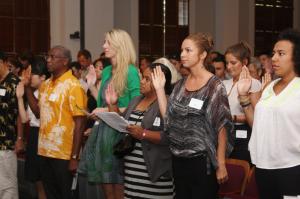By Staff Reports
(Oahu)– While law schools across the country continue to face declining enrollments, the William S. Richardson School of Law at the University of Hawai‘i at Mānoa campus has welcomed the largest incoming class in its 41-year history.
The class size for the full-time program this Fall has almost doubled in size from a year ago, with 99 incoming JD candidates this year compared to 53 last year. The Law School also enrolled 24 students in its Evening Part-Time program; another 7 candidates in the LLM (Masters of Law) program; 7 students in its new Advanced JD program; 6 transfer students and 2 visiting students. With all categories included, the Fall 2014 entering class stands at a total of 145 students.
While the UH Law School is one of the smallest in the country, it consistently ranks among the nation’s top tier of American Bar Association-accredited law schools in the annual U.S. News & World Report, and is one of the most diverse for its mix of students and faculty.
Said Law School Dean Avi Soifer, “We are very excited to have so many students taking advantage of our personalized instruction and our relatively low tuition. They can expect the rare experience of a rigorous legal education that students actually like. And the word is out that our students actually support each other and that they can expect to get challenging legal jobs.”
He added, “This substantial upturn in enrollment did not just happen. Elisabeth Steele Hutchison, our Director of Admissions, her staff, and the faculty and students on our admissions committee — as well as many other faculty and staff members — worked hard to attract these extraordinary students. In addition, Professor Alison Connor helped develop and implement our new Advanced JD program and we recruited outstanding students for the first class.”
In a transformative moment during this week’s orientation activities, the incoming class stood in the hushed Supreme Court, raised their right hands, and took the Richardson student pledge, administered by Hawai‘i Supreme Court Chief Justice Mark Recktenwald with the entire Supreme Court bench looking on.
Each year, as part of the pledge, the incoming class commits itself to “zealously guard legal, civil and human rights . . . and above all to endeavor always to seek justice.”
Before the pledge, Recktenwald noted that there is “a great partnership between the Law School and the Supreme Court,” pointing out the valuable work law students do in the community, often in conjunction with the Court’s own outreach programs. “What it means to be a Richardson law student is a commitment to access to justice, and a commitment to civility and professionalism,” the Chief Justice told the students. “What really stands out is that those commitments have been embraced by the students.”
Recktenwald said that Richardson law students have been a “driving force” in creating and staffing clinics like the child welfare clinic, as well as in developing the idea for a new program to link loan repayment to community service after graduation. That concept is now under study by a task force created by the Hawai‘i Legislature. “All of this really makes this Law School unique,” said Recktenwald.

